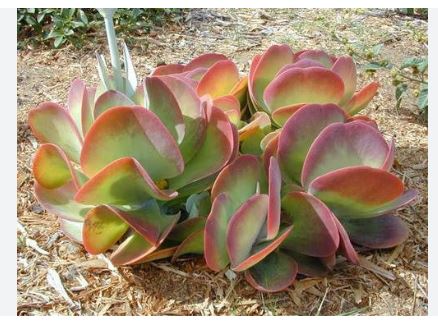
Kalanchoe luciae, the paddle plant or flapjacks, is a species of flowering plant in the genus Kalanchoe, native to northeast South Africa, Eswatini, Mozambique and Zimbabwe. It has gained the Royal Horticultural Society’s Award of Garden Merit.
The plant thrives in a climate with hot summers and cooler winters, though it’s frost-sensitive. Its habitat experiences a summer-rainfall pattern, which influences its water needs. It grows in rocky outcrops, cliffs, and sometimes in grassy slopes or among shrubs where it can benefit from natural drainage and protection from excessive moisture.
Kalanchoe luciae is part of the Afromontane flora, which means it grows in areas where the vegetation is adapted to mountain conditions, often alongside other succulents, grasses, and indigenous trees and shrubs.
Characteristics
- Leaves: The most distinctive feature of Kalanchoe luciae is its large, flat, paddle-shaped leaves. These leaves are thick and fleshy, typically arranged in a rosette. They are green but often develop red, orange, or pink edges, especially when exposed to bright light. The leaves can grow up to 6 inches (15 cm) long and 4 inches (10 cm) wide.
- Flowers: In spring, it produces small, bell-shaped flowers on tall stems. The flowers are usually pale yellow or orange and appear in clusters at the top of the stalk.
- Growth Habit: This plant grows in a rosette form, staying relatively low to the ground, but can start to elongate or “stretch” if not receiving enough light, a process known as etiolation.
- Size: In cultivation, it usually grows to about 1-2 feet (30-60 cm) tall and wide, though it can be smaller or taller depending on growing conditions.
- Texture: The leaves have a glossy finish, and the surface might be slightly rough or have a powdery bloom.
Cultivation
- Light: Prefers bright, indirect light or morning sun with afternoon shade. Full sun can enhance the red margins of the leaves but too much can scorch them. Ideally, place it where it gets at least 4-6 hours of sunlight daily.
- Soil: Use a well-draining cactus or succulent mix. Adding perlite, pumice, or coarse sand can improve drainage. The soil should be light and airy to mimic the natural rocky, well-drained environments of its habitat.
- Watering: Water sparingly. Allow the soil to dry out completely between waterings. Overwatering is a common cause of root rot in succulents. During winter, reduce watering even more, as the plant enters a dormant phase. Water more frequently in spring and summer when the plant is actively growing.
- Temperature: Can tolerate a range of temperatures but thrives best in 60-75°F (15-24°C). It’s not frost-tolerant, so in areas with frost, it should be brought indoors or protected.
- Humidity: This plant is adapted to low humidity environments, typical of its native habitat, so it does well in the average home environment without added humidity.
- Fertilization: Feed with a diluted succulent fertilizer during the growing season (spring and summer). Monthly feeding with a half-strength solution is generally sufficient.
- Repotting: Repot every couple of years to refresh the soil or if the plant outgrows its pot. Use shallow pots since the plant has a shallow root system.
- Propagation: Easily propagated from leaf cuttings. Simply remove a leaf, let it callus over for a few days, and then place it on top of well-draining soil. Roots and new plants will form at the base of the leaf. Stem cuttings can also be used.
- Pests and Problems: Watch for mealybugs and aphids. Use insecticidal soap or neem oil for control. Overwatering can lead to root rot, so ensure good drainage.
Additional Tips
- Outdoor Cultivation: In areas where the plant can be grown outdoors year-round, ensure it has protection from the hottest part of the day in summer and full sun in cooler months to maximize coloration.
- Safety Note: Some Kalanchoe species can be toxic if ingested, so handle with care, especially if you have pets or small children.